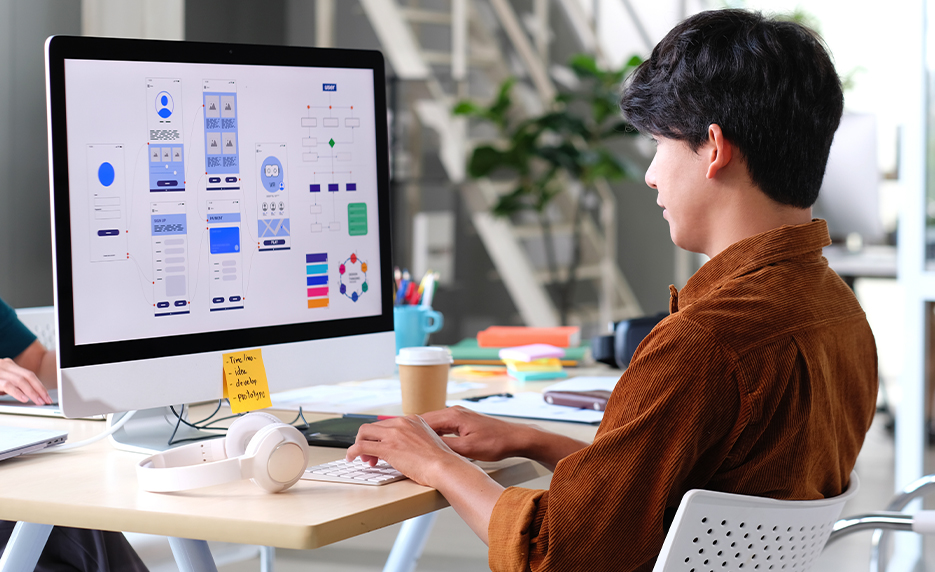Elevate Your Online Existence With Magnificent Website Design Tips and Trends
The interaction of aesthetic charm, present design patterns, and user experience plays a critical duty in attaining this objective. The nuances of reliable layout expand past aesthetics; understanding essential techniques for optimization can substantially affect your success.
Value of Visual Appeal
In today's digital landscape, the aesthetic charm of a website is paramount; researches show that 94% of impressions are design-related. This fact underscores the vital function that aesthetics play in user involvement and retention. A well-designed internet site not only draws in site visitors yet also urges them to discover its content even more. Efficient visual layout incorporates elements such as color design, images, layout, and typography, every one of which add to a natural and attractive individual experience.
In addition, a visually appealing site infuses a sense of integrity and professionalism and trust. Individuals are most likely to trust a site that looks well-structured and sleek, which can significantly impact conversion prices. On the other hand, a unpleasant or cluttered style can cause high bounce rates, as customers might regard the web site as undependable or outdated.
Moreover, the appearances of a website can convey brand identity and worths (Web design). Regular use branding components, such as logo designs and shade combinations, enhances recognition and fosters a deeper connection with the audience. In final thought, focusing on visual charm is crucial for producing appealing, trustworthy, and brand-aligned online experiences that resonate with customers
Present Design Fads
Modern website design is frequently progressing, and staying upgraded with present trends is vital for producing impactful on the internet experiences. One noticeable fad is the surge of minimalism, defined by clean lines, ample white room, and an emphasis on essential components. This strategy not only improves use but also enables web content to take facility phase.
Furthermore, dark mode user interfaces have actually gotten popularity, giving customers with an aesthetically striking alternative while reducing eye strain. This fad straightens well with individual preferences, providing a modern visual that is both functional and stylish.
An additional notable fad is the consolidation of vibrant typography. Developers are increasingly utilizing large, expressive fonts to develop visual pecking order and convey brand name messages effectively. Paired with lively shade combinations, this fad adds dynamism to internet pages.

Vital Design Components
Effective internet design pivots on several necessary style aspects that with each other create a engaging and cohesive user experience. The initial of these aspects is format, which dictates how web content is arranged on the web page. A well-structured design not just enhances readability however additionally guides customers through the site flawlessly.
Shade plays an essential function in layout, affecting emotions and brand understanding. An unified color combination can evoke particular feelings and develop an aesthetic hierarchy, thus attracting attention to essential aspects. In a similar way, typography is vital; the option of fonts must align with the brand identification and guarantee clarity throughout tools.
Imagery, including graphics and images, includes aesthetic passion and can communicate messages rapidly. Top notch photos relevant to the content improve the general aesthetic and interaction. Furthermore, whitespace is usually overlooked but is necessary for creating balance. It helps avoid clutter, allowing customers to concentrate on the crucial components without distraction.
Last but not least, consistency throughout all layout components reinforces brand name identification and makes navigating instinctive. By meticulously incorporating these important layout elements, web designers can create useful and aesthetically appealing internet sites that captivate site visitors and their explanation urge communication.
Individual Experience Optimization
A smooth user experience is important for maintaining visitors and driving conversions on a website. Maximizing individual experience (UX) includes understanding your audience and customizing layout elements to fulfill their demands properly. Secret components of UX optimization include intuitive navigating, quick filling times, and clear calls to activity.
To boost navigating, make sure that food go to website selections are organized logically and obtainable from any type of web page. Integrate breadcrumb trails to aid customers quickly backtrack, reducing irritation. Speed is another important element; sites need to fill within three seconds to protect against individuals from abandoning the site. Use devices like picture compression and internet browser caching to optimize lots times.
Moreover, your site's style need to focus on clearness. Usage understandable typefaces, contrasting shades, and whitespace to produce a visually attractive design that overviews individuals via web content easily. Calls to action ought to be plainly displayed, utilizing actionable language that encourages users to involve.
Mobile Responsiveness Strategies
Nearly fifty percent of all internet website traffic currently originates from smart phones, underscoring the value of executing durable mobile responsiveness approaches. To guarantee ideal customer experience throughout different screen sizes, web designers must welcome a liquid grid format that adapts perfectly to investigate this site different tools. This technique allows web content to resize and restructure without compromising functionality or looks.
Integrating flexible photos and media queries is necessary. Pictures should instantly adjust their size according to the viewport, while media questions can identify gadget qualities and apply tailored CSS styles accordingly. This strategy enhances load times and makes certain that users have a visually attractive experience.
Additionally, focus on touch-friendly navigation components. Buttons and links need to be quickly tappable, with sufficient spacing to protect against misclicks. Preventing hover-dependent communications better improves use on touchscreens.
Lastly, performing routine screening across different tools and internet browsers is important. Devices like Google's Mobile-Friendly Test can help determine areas needing improvement. By taking on these mobile responsiveness strategies, services can boost individual involvement, increase online search engine rankings, and eventually drive conversions, therefore elevating their on the internet presence properly.
Verdict
By prioritizing aesthetic appeal via current design fads and vital components, services can foster reputation and engagement. Maximizing individual experience and ensuring mobile responsiveness are vital for helping with seamless communication across devices.

Conversely, a unattractive or chaotic layout can lead to high bounce rates, as users may regard the website as undependable or out-of-date. - Web design
Reliable web style pivots on a number of crucial design components that together produce a appealing and natural user experience. Maximizing individual experience (UX) entails understanding your target market and tailoring layout aspects to fulfill their needs effectively.